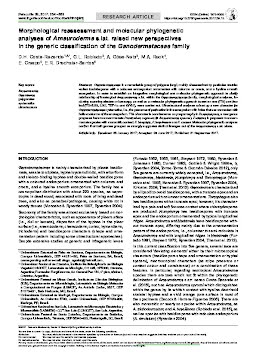2017
Morphological reassessment and molecular phylogenetic analyses of Amauroderma s.lat. raised new perspectives in the generic classification of the Ganodermataceae family
Publication
Publication
Persoonia - Molecular Phylogeny and Evolution of Fungi , Volume 39 p. 254- 269
Ganodermataceae is a remarkable group of polypore fungi, mainly characterized by particular doublewalled basidiospores with a coloured endosporium ornamented with columns or crests, and a hyaline smooth exosporium. In order to establish an integrative morphological and molecular phylogenetic approach to clarify relationship of Neotropical Amauroderma s.lat. within the Ganodermataceae family, morphological analyses, including scanning electron microscopy, as well as a molecular phylogenetic approach based on one (ITS) and four loci (ITS-5.8S, LSU, TEF-1α and RPB1), were carried out. Ultrastructural analyses raised up a new character for Ganodermataceae systematics, i.e., the presence of perforation in the exosporium with holes that are connected with hollow columns of the endosporium. This character is considered as a synapomorphy in Foraminispora, a new genus proposed here to accommodate Porothelium rugosum (≡ Amauroderma sprucei). Furtadoa is proposed to accommodate species with monomitic context: F. biseptata, F. brasiliensis and F. corneri. Molecular phylogenetic analyses confirm that both genera grouped as strongly supported distinct lineages out of the Amauroderma s.str. clade.
| Additional Metadata | |
|---|---|
| , , , , | |
| doi.org/10.3767/persoonia.2017.39.10 | |
| Persoonia - Molecular Phylogeny and Evolution of Fungi | |
| Released under the CC-BY 4.0 ("Attribution") License | |
| Organisation | Naturalis journals & series |
|
Costa-Rezende, D. H., Robledo, G. L., Góes-Neto, A., Reck, M. A., Crespo, E., & Drechsler-Santos, E. R. (2017). Morphological reassessment and molecular phylogenetic analyses of Amauroderma s.lat. raised new perspectives in the generic classification of the Ganodermataceae family. Persoonia - Molecular Phylogeny and Evolution of Fungi, 39, 254–269. doi:10.3767/persoonia.2017.39.10 |
|
